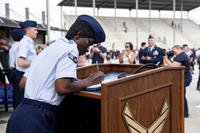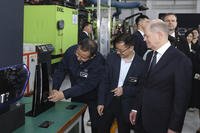Navistar International Corp. says bomb-resistant trucks it built for military operations in Iraq and Afghanistan could soldier on with new communications gear and power upgrades.
The U.S. military, mostly the Army and Marine Corps, spent more than $45 billion during the past decade on so-called Mine-Resistant Ambush Protected vehicles, known in military parlance as MRAPs, to shield troops from deadly roadside bombs. Now, with the Afghanistan conflict coming to an end, the Army is trying to figure out what to do with the hulking trucks.
The Army bought some 27,000 of the vehicles, including about 9,000 MaxxPros made by Lisle, Ill.-based Navistar's defense unit. The service only plans to keep about 3,000 of the latter, according to John Akalaonu, a senior program manager for the company. The vehicles, many of which were used as troop carriers and ambulances, can be upgraded to become mobile command posts or power generators, he said. One such truck was on display at the Association for the United States Army conference this week in Washington, D.C.
"We're trying to show them what that vehicle is capable of," Bob Walsh, vice president and general manager of Navistar Defense, said during an interview at the show. "We see a highly maneuverable, highly armored platform."
Faced with declining budgets, the Army won't be able to afford everything it wants, Walsh said. But with fewer dollars, it might be able to upgrade existing weapons or equipment to get a solution that's good enough, he said.
"Take a pause," he said. "While you're looking at all these future requirements, what are you doing with this existing fleet that you have?"
The vehicle on display was designed as a mobile command post, known as Mission Command on the Move, or MCOTM. It featured an assortment of monitors, computers and antennae mounted in the back for communications and surveillance. The truck was also outfitted with an on-board vehicle power system, a transmission-integrated generator that produces as many as 120 kilowatts of exportable power, according to Akalaonu.
"With this, you eliminate the need to tow a trailer," he said. "You reduce your vehicle footprint."
The truck is scheduled to undergo testing at the Army's semi-annual battlefield network tests, known as the Network Integration Evaluations, or NIEs, in February at Fort Bliss, Texas, Akalaonu said.
Many of the MRAPs the military doesn't plan to keep are being given to allies, sold for scrap or transferred to law enforcement agencies in the U.S., company officials said. Even Ohio State University's public safety department plans to receive one of the hand-me-down war trucks, they said.








